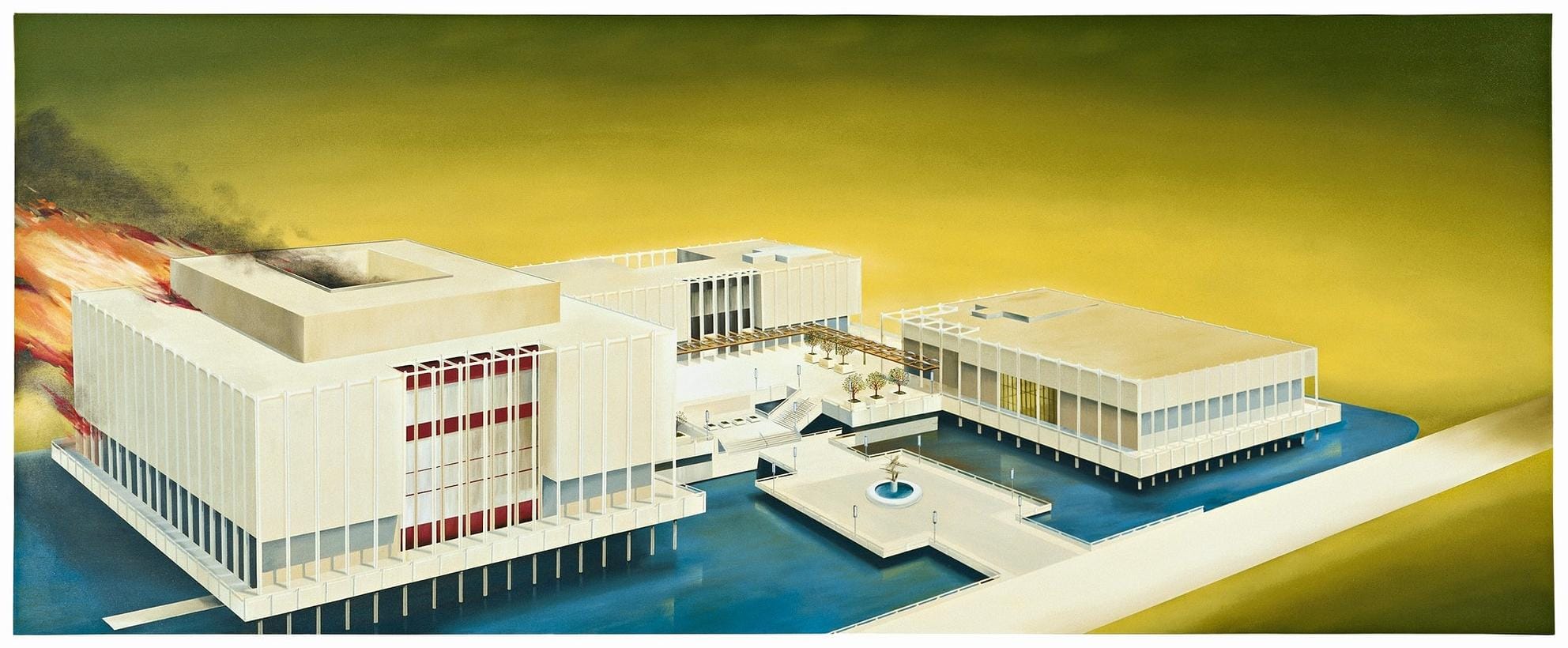ED RUSCHA/ NOW THEN
Los Angeles County Museum of Art
Los Angeles
Through Oct. 6, 2024
Ed Ruscha imagines a Los Angeles where LACMA is burning. It’s surprisingly serene. After all, I smiled manically looking at it at 5:00 p.m. last Monday: The Los Angeles County Museum of Art on Fire (1968), one of Ruscha’s most provocative paintings, depicts LACMA ablaze, swallowed by a dark, yellow-green fog. The scene incites precisely the queasy and seductive thrill that punctuates the renowned pop artist’s legacy. His retrospective ED RUSCHA / NOW THEN, up through October at the Los Angeles County Museum of Art, ushers viewers into a technicolor world; there, objects, words, and landmarks shrink and expand in cosmic proportions to create playful and outrageous renderings of a city rotted by consumerism and pop culture. The effect is delightful and troubling — a peculiar, pleasure-infused dread known intimately by L.A. residents.
Though Ruscha — along with the likes of Joan Didion, Charles Bukowski, and Barbara Kruger — has been anointed as one of this city’s defining voices, the artist grew up in Oklahoma. As such, he’s both an insider and an intruding voyeur. In Ruscha’s universe, mass media is a beautiful but beguiling plague, corrupting everything it touches. In the print Landmark Decay (2006), the Hollywood Sign disintegrates. In the painting Back of Hollywood (1977), it’s enveloped by a red-orange smog suggestive of apocalyptic doom. Strung up along the walls of the exhibit, Ruscha’s paintings, drawings, and prints are preoccupied with symbols of Californian glamour and debris (martini olives, painkillers, NORMS diners), exuding the same cool sexiness that Eve Babitz (who dated both the artist and his brother Paul) once described in her novels — a by-product of relentless, too-easy living. In whimsical paintings from the mid-1960s, Ruscha depicts alliterations and puns on an epic scale, employing his signature “megaphone effect” slant. “A word has no size,” Ruscha once said, and considering his words from a distance, I had to agree: “Honk,” “Ace,” and “Boss” took on new meaning, at once enormous and tiny, elastic and futile.
Ruscha’s conceptual art dispels clichés about conceptual art — namely, that it need be purposefully obtuse or smug. (By contrast, this work is funny and gleefully rude.) During the late 1960s and early ’70s, Ruscha began to explore what he characterized as a “romance with liquids,” forming words on canvas from puddles of honey and water, and reaching for a range of materials including Pepto Bismol and blood. Chocolate Room (1970), arguably his most ambitious piece, is simply that: a room lined with thin sheets of chocolate. Another series of drawings traces cursive words in a fine white grain from gunpowder pellets. In this way, even in their final form, the works’ underlying, meticulous methods are evident — and equally as compelling as the final pieces.
I left NOW THEN with a renewed adoration for my city, the stage for so much of Ruscha’s neon violence and nihilism. For six decades, the artist has pursued unnerving yet joyful truths about California life. One photo collage compiles every building on the Sunset Strip, cutting and pasting all its sleaziness and grime into a slick mess of black and white. The latter portion of the exhibit displays Ruscha’s aerial shots of Los Angeles — Dodger Stadium, parking lots, and suburbs shrunken down. Studying these pictures, I couldn’t help but think how peaceful, how tranquil it all looked from up there. I live here, I thought. And then, if only fleetingly: I am so lucky.






